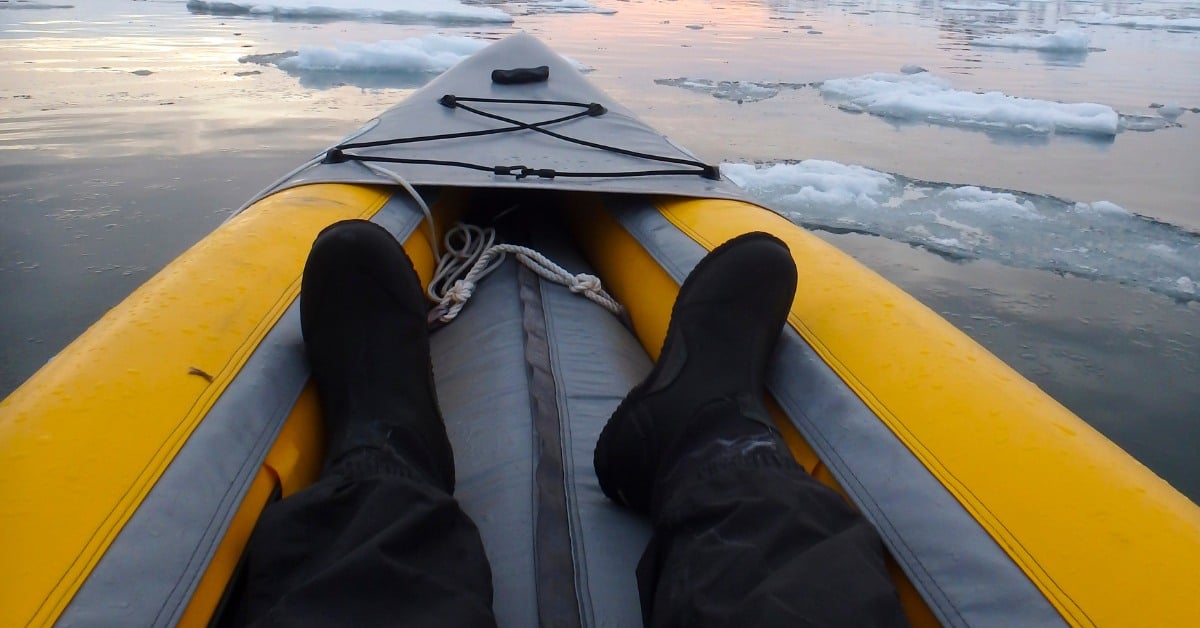Preparing for cold weather kayak fishing is extremely important if you are considering lengthening your yak angling experience. Deciding when to start preparing for cold weather kayak fishing is dependent on water temperature, not the time of year.
Here is a table of simple guidelines on suggested clothing types for various water temperature ranges.
| Water Temperature | Hypothermia Risk | Appropriate Clothing |
|---|---|---|
| 60°F and Up | Low | Weather appropriate |
| 55°F – 59°F | Moderate | Wetsuit/Drysuit |
| 45°F – 54°F | High | Drysuit recommended |
| Below 45°F | Extreme | Drysuit strongly recommended |
The table above recommends the use of a wetsuit or dry suit for water temperatures below 60°F (roughly 15 Celsius). I opt to use layering of clothing when the water temperature falls below 60°F because I feel that a drysuit is out of my price range. Besides layering my clothing, I also carry a change of clothes in a dry bag in case I fall out of the kayak, the kayak turtles, or run into an unexpected rainstorm.
Hypothermia is a potentially dangerous drop in body temperature, usually caused by prolonged exposure to cold temperatures. Normal body temperature averages 98.6°F (37 C). With hypothermia, the core temperature drops below 95°F (35C). In severe hypothermia, core body temperature can drop to 82°F (27 C) or lower.
Also Read
You should know the signs of hypothermia. These signs are skin that is cold to the touch; shivers and then no shivers; drowsiness; clumsiness; confusion; slowed breathing and heartbeat; hunger, etc. Watch for them in yourself and in your fishing buddies while on the water.
Remember, fishing in cold water is risky. You will need to have the skills to handle the conditions that you expect and be ready for the worst. If you elect to try cold-weather kayak fishing, only go on days that are well within your skill levels. Always approach cold weather fishing with a conservative risk management plan, as there is little room for error when the water and air temperature are cold.
My number-one rule for kayak fishing in cold weather is to never fish alone. When the water temperature falls below 55°F (12 degrees C), hypothermia risk is high. You will need that buddy to assist in water rescue in case you fall into the water.
The second rule is that you need to wear a PFD. Wear either a traditional PFD or a self-inflating PFD. A manual-inflating PFD might not save your life if the water is near 35°F (1 degree C) because you might not be aware of your issue because your breath will be taken away. If this warning scares you, it is intended to do just that.
Cold Weather Kayak Fishing Gear
Before I describe what is in my cold water kayak fishing gear: I need to stress that the items in the dry bag are only to replace the wet clothing to help delay the risk of hypothermia, NOT to continue fishing!
You will still need to get off the water as fast as possible so that you can reach a warm place, like your vehicle or, even better, home. In the dry bag, I have Frogg Toggs Pro Action Rain Suit – it is waterproof and windproof; Simms Coldwater Pants with a nylon shell fabric on the outside along with a polyester fleece lining; a long-sleeve fleece quarter zip or pullover sweater; wool socks; and fresh underwear.
I place this dry bag in my front hatch or under the bungee cords in the rear tank well if I’m not carrying the cooler or crate. The contents of the dry bag are very important, as wearing wet clothes dramatically raises your risk of hypothermia.
Now that we have our emergency dry bag assembled for cold-weather fishing let me describe how I prepare for fishing in the cold weather.
First, the secret to staying warm is staying fed and hydration. I will plan to have a good breakfast, like steel-cut oatmeal and juice, before heading out into the cold. While on the water in cold weather, you will need to continue to feed your body to maintain your body temperature, so plan on bringing a lot of water energy drinks and snacks.
Cold Weather Kayak Fishing Clothes
I dress in layers for cold weather. The first layer needs to be self-wicking. You do not want that body moisture to stay on your skin, and the clothing act as insulation. The moisture will cause your body to start feeling cold as the clothing retains this liquid. The next layer is a pair of Simms Coldwater Pants, a long-sleeve fleece sweater or shirt, and wool socks. I wear chest waders over the first and second layers to help with the paddle spray.
Of course, safety is always number one, so I also wear a wader belt to help in preventing water from getting into the waders. Over the waders, I wear a Storm Creek jacket that is water and wind resistant. Over the jacket, I wear my PFD to add another layer to keep me warm. This layering of clothing works really well here in the Lowcountry of South Carolina. I can remove clothing when I get warm and add clothing when I feel cold. Remember, when removing layers, always put that PFD back on.
Using this concept of layering clothing, you, as a kayak angler, should be able to adapt my method to extend your fishing adventures. Remember, the most important elements to prevent hypothermia are to keep hydrated, dress in layers, have a dry bag with extra clothing, and, most important, stay away from cotton clothing – this material will hold water and not dry out quickly.
To continue to enjoy the outdoors, whether you are kayak fishing, hunting from a kayak, or enjoying the winter activities in your area, keep this proverb in mind: “There is no bad weather, only the wrong gear.” This will always help you to be prepared for the cold weather kayak fishing, so you can enjoy more adventures in the winter months.






